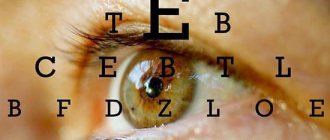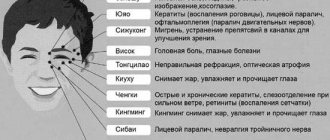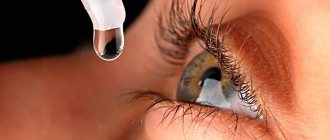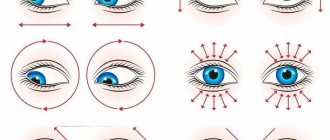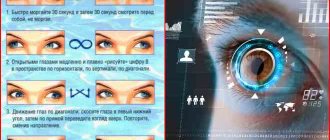Today no one disputes the effectiveness of eye gymnastics. It helps improve vision and is one of the best means of preventing the development of refractive errors. There are different types of eye exercises that are performed for farsightedness. They will be beneficial if they are performed correctly.
In this article
- How does farsightedness manifest?
- What are the benefits of vision exercises for farsightedness?
- What are some eye exercises for farsightedness?
- How to properly perform eye exercises for farsightedness
- Eye exercises for farsightedness according to Bates
- Eye muscle training using the Zhdanov method
- Gymnastics for the eyes according to Norbekov
- Children's gymnastics for farsightedness
How does farsightedness manifest?
Impaired refractive power of the eyes, in which a person has difficulty seeing close up, is called farsightedness or hyperopia. This pathology develops as a result of injuries to the organs of vision, tumors in the eye area, infectious ophthalmological diseases and other reasons. In most cases, hypermetropia is caused by a genetic predisposition.
Deterioration of vision with farsightedness occurs quite quickly if measures are not taken to treat or correct it. Hyperopia can be corrected with contact lenses and glasses, but the best way to get rid of the pathology is laser surgery. Unfortunately, laser vision correction has contraindications. It is not prescribed to minors and people with various severe pathologies of the body and visual organs. Such patients have to live with farsightedness, compensating for it with glasses and lenses. They also have their drawbacks. So, not everyone tolerates glasses and contact lenses well. In addition, these remedies do not help cure farsightedness.
If a person’s life is associated with constant strain on the eyes, hypermetropia will cause discomfort even when using optics. This discomfort manifests itself in eye fatigue, headaches, dizziness, dry cornea or tearing. Eye exercises can help prevent these symptoms. For farsightedness, gymnastics are prescribed, which may differ from eye exercises performed for myopia. Let's look at the main types of gymnastics that help with hypermetropia.
What is farsightedness and myopia in simple words?
Farsightedness is a decrease in near vision when objects appear blurry. And with myopia, distant objects lose clarity.
Farsightedness and myopia: differences
- These refractive errors differ in where the rays are focused: in hyperopia, they are refracted behind the retina, and in myopia, they are refracted in front of it.
- With myopia, distance vision is impaired, and with hypermetropia, near vision is impaired.
- To correct myopia, diverging lenses are used, and for hyperopia, collective lenses are used.
Farsightedness – is it a plus or a minus?
From the above we can conclude that hypermetropia is a plus.
So, hyperopia (farsightedness) is a pathology of refraction in which rays are reflected from an object and focused behind the retina.
Pathology is divided into the following degrees:
- Weak degree: from +0.25 to +1.75 D.
- Medium : +2.0 to +5.0 D.
- High : over +5.25 D.
What are the benefits of vision exercises for farsightedness?
To restore the vision of farsighted people, many different exercises have been developed that can be performed by adults and children. Any gymnastics for vision provides:
- improving vision by normalizing blood circulation in the eye, as well as in the cervical region and spine;
- strengthening the eye muscles;
- increasing the accommodative ability of the lens.
For farsightedness, eye exercises help relieve fatigue from the visual organs, train the eye muscles, and increase visual acuity. All this helps stop the development of hypermetropia, if it progresses, and delay the onset of age-related farsightedness - presbyopia. In childhood, eye exercises are especially useful.
Children experience a heavy load on their visual organs at school, and during the formation and growth of the body and eyes, this can provoke an even greater decrease in visual acuity. Gymnastics allows you to stop the progression of the pathology, so that farsightedness can completely disappear by the age of 18-20.
The effectiveness of gymnastics
Restoring vision if you perform gymnastic exercises is possible. But for this you need to do them constantly. Another important condition for effective vision correction and preventing its further deterioration is wearing properly selected glasses. If they are selected incorrectly, then further deterioration in visual function and the development of dangerous lesions of the visual analyzer are possible.
With systematic exercise for the eyes, the following effects are observed:
- increased visual acuity;
- increased tone of the eye lens;
- improving blood circulation in the eye;
- toning the eye muscles;
- relieving fatigue after prolonged and intense visual work.
The first positive changes are noted within a month after the start of physical education for the eyes.
How to properly perform eye exercises for farsightedness
Before you start performing eye exercises, remove your glasses or contact lenses if you use them. You can perform exercises only if you feel well, do not have elevated temperature or blood pressure, eye diseases or other ailments. You can train your eye muscles with the following exercises:
1. Sit straight on a chair, turn your head and look to the right, then take your starting position. Next, you need to turn your head to the left and look away in the same direction. This task should be completed 10-15 times. 2. Move one hand 30 cm away from your eyes. Hold your gaze for 10 seconds at the tip of your index finger. After this, focus on some object that is located further than your hand. Repeat 10 times. 3. Place your hands behind your head, elbows bent. Bend at the waist, place your feet on your toes. Fix your body in this position for a few seconds, and then relax. Repeat these steps 5-7 times. 4. Extend one hand forward so that the distance between it and your face is 40-50 cm. Next, you should perform clockwise circular movements with your hand, without taking your eyes off your fingers. After that, repeat the same task, but with your other hand raised. The next step involves turning the arm counterclockwise. Training the eye muscles in this way lasts 3-5 minutes.
The final stage will be massaging the neck and back of the head. You need to do eye exercises every day. At the same time, you should not overload yourself. If you feel tired, take a break. All these exercises allow you to relax the muscles of the eyes, as well as the neck and spine. Their advantage is that they take little time. In addition, such exercises have no contraindications and can be performed by everyone even without visiting an ophthalmologist. It is also suitable for people without farsightedness as a way to relieve tension from the eye muscles and take a little break from work.
Eye exercises for farsightedness according to Bates
Ophthalmologist Bates, in order to relax the eyes, strengthen the eye muscles and restore vision, offers a rather unusual set of exercises:
1. Read a book or newspaper with small print every day. The text must be at a distance of 25 cm from the person. Correction tools cannot be used when reading. At the same time, it is also not recommended to strain your eyes too much. This will lead to even more fatigue. When you read, try to look between the lines. This way the eye muscles will not strain too much. This exercise should take no more than 15 minutes. 2. Prepare a Sivtsev table in two formats to test visual acuity. It can be printed on several A4 sheets. One table should be of standard size, like in an ophthalmologist’s office, and the second should be small. Attach a large poster to the wall and move 5 meters away from it. The smaller table needs to be held in your hands. The exercise consists of alternately reading a large and a small table. The gaze, as in the previous task, needs to be directed between the lines. The exercise is performed for 3-5 minutes. 3. For the next task you will again need a large format Sivtsev table. Now you need to alternately look at it and then at other objects located in the room. The ideal way to perform the exercise is to observe moving objects, for example, a bird in a window or a cat in a room.
4. The fourth exercise must be done while standing facing the window. Perform body turns while concentrating on an object outside the window. Movements should be smooth and slow. Place your feet shoulder-width apart and lower your arms along your body. Repeat the turns, always looking forward, for 2-3 minutes.
These exercises may not be suitable for everyone. It can be difficult to read a book without glasses if your refractive error is severe, even for just 15 minutes. Performing eye exercises using the Bates method must be approved by your attending physician.
Improving vision according to Norbekov
Mirzakarim Norbekov (born 1957) is a writer, developer of his own methods of restoring health and self-improvement, head of the M. S. Norbekov Center for Educational and Health Technologies. One of the most famous books is “The Experience of a Fool or the Key to Insight. How to get rid of glasses."
Purely technically, Norbekov’s technique is based on the same principles as Bates and Zhdanov—training some muscles and relaxing others. However, two significant additions appear: “joint” gymnastics and auto-training. Joint gymnastics is a set of exercises to maintain posture and spinal health. This is necessary, among other things, to normalize blood circulation in the head and neck, as well as directly in the eyeballs.
Autotraining is the basic principle of Norbekov’s methodology. All his exercises will work only if you have a deliberately positive attitude and faith in the result. According to Norbekov, only by changing yourself and your attitude towards the world can you achieve positive dynamics in your health, including your vision. For many, auto-training is the most difficult moment of the entire technique. To master it, it is best to read the book “The Experience of a Fool or the Key to Insight. How to get rid of glasses." And don’t just read it, don’t be lazy and complete all the tasks listed there along the way. All of them are aimed at self-improvement, victory over laziness and self-confidence.
IMPORTANT! Without these components, as Norbekov himself writes, mechanical repetition will not bring much benefit.
Be that as it may, M. Norbekov’s system today is the most holistic and effective of all the popular non-medical methods of vision restoration. Below is an approximate scheme of classes for eyes with farsightedness for a week.
Lesson plan for the week
- Accommodation exercise. You need to stick a small picture on the window, about the size of a passport photo. Standing at a window at a distance of 20-25 cm, you need to alternately look from the picture on the glass to objects on the street. For example, a TV antenna, a bird, a cat on the roof, etc. Then return your gaze to the picture for 5-10 seconds, and again into the distance. And so on for 10 minutes. The essence of the exercise is to return to the picture on the glass and maintain the state of the eyes in which they were when looking at objects in the distance. The frequency of the exercise is 2 times a day for 10 minutes.
- Exercises for training the eye muscles according to Bates - 2 times a day for 10 minutes, morning and evening.
- Exercises with check tables - 2 times a day, also in the morning and evening. You can use Sivtsev’s standard table, printed in A5-A6 format, but it is better to take Norbekov’s original tables. It’s much nicer and more fun to work with them. They can be found in the book “The Experience of a Fool...” or printed out yourself.
- If you are farsighted, the test chart should be kept at a distance of 15-20cm from the eyes. In the table you need to find a working line - one above which you can see well, below which you can see poorly. The exercise “3 sets of 30 seconds” is performed with the working line. Required within 30 seconds. glide your eyes along the line, not trying to strain your eyesight and look at the details, but at the same time anticipating a “glimpse” of improved vision. This is followed by 30 seconds of palming and another approach, and so on 2 more times.
- Solarization - 10 min. every morning.
- Practice “breathing with your eyes” several times throughout the day. A very simple and effective exercise - you need to imagine that air, when breathing, penetrates through the eyelids of your closed eyes. At the same time, when you inhale, you feel coolness, and when you exhale, you feel warmth. Duration: 5-10 minutes, can be combined with palming.
Each exercise ends with palming to relax the eyes.
IMPORTANT! Classes according to the Norbekov system are not recommended for retinal detachment, recent eye surgeries, as well as states of stress and strong emotional tension.
Mirzakirim Norbekov insists on conducting classes only in a state of joy and a positive attitude. If you feel tired, irritated, or unwilling to exercise, it is better to postpone visual gymnastics until another time.
The video shows exercises to improve vision according to Norbekov. Keep your posture straight, have a smile on your face, train your eye muscles, and most importantly, keep a positive attitude:
Eye muscle training using the Zhdanov method
Russian ophthalmologist Zhdanov suggests training the eye muscles with the following exercises:
1. Take a pencil in your hand and extend it forward. First, look at various objects in the room, blink a few times, and then focus on the tip of the pencil. Bring it closer to your face so that the distance between it and your eyes does not exceed 15 cm. Next, move your hand to a distance of 30-40 cm from your face. Repeat this exercise 5-10 times. 2. Bring the pencil close to your face, looking forward and into the distance. Tilt the pencil in different directions. Then move your hand away from your face 20 cm and return it to its original position. Your gaze should not rest on the tip of the pencil during the entire exercise. The task takes about 3 minutes to complete.
These exercises are suitable for everyone and can be performed without first consulting a doctor.
Farsightedness in children
At birth, all babies have hypermetropia. In the absence of congenital pathologies, the disorder is restored by the age of 6, and by the age of 16, the disease should completely disappear. Otherwise, various forms of pathologies associated with decreased vision develop. Correction is carried out by selecting glasses, painless medications, as well as a light set of exercises:
- Massage closed eyes for 5–10 seconds using gentle finger pressure.
- Focusing the gaze starting from nearby objects, gradually moving into the distance and vice versa.
- Mental drawing of numbers with closed eyelids.
Watch the diet, take your child to outdoor games that promote the development of the accommodative apparatus (tennis, volleyball, badminton).
| Careful and regular examination by a specialist, lenses and gymnastic exercises can correct vision and prevent complications of the disease. |
Children's gymnastics for farsightedness
Gymnastics, which is prescribed to children with farsightedness, is somewhat different from the exercises described above. Children can complete tasks only under the guidance of adults. Parents should ensure that the child does the exercises correctly. He should stand in front of the window, extend one arm forward, turning it with the palm towards his face. First, the child should look at the palm, looking at the lines on it. Next, he should look at the window frame, and then focus on the picture outside the window. The task ends by shifting the gaze from the objects outside the window to the frame, and then back to the hand.
These exercises help you take your mind off school, rest a little, and relax your eye muscles. In general, the essence of this technique is the same as in other exercises, but it is performed under the supervision of an adult. Parents can come up with some kind of game that will exercise the eyes. It is necessary to ensure that tasks are completed correctly and that the child does not become overtired.
The benefit of eye exercises for farsightedness will only be if it is performed daily. In addition, do not neglect correction means. An integrated approach to correcting refractive errors helps prevent the negative consequences of hypermetropia - amblyopia, strabismus, glaucoma and other diseases.
Can treatment consist only of gymnastics?
Unfortunately, diopters are not extra pounds and “losing” them with the help of visual gymnastics is not so easy. True, some enthusiasts claim that they were able to completely restore their vision, having +7 or more diopters. It is unlikely that this is actually true. Official ophthalmology does not have confirmed data on the effectiveness of eye exercises.
Nevertheless, any ophthalmologist will confirm their undoubted benefits for several reasons:
improving blood circulation in the eyeball, nutrition of the retina and eye muscles;
- maintaining the main groups of eye muscles in tone;
- maintaining the lens in the correct position;
- slowing down or stopping vision deterioration, including age-related farsightedness;
- proper rest and relaxation of the eyes after visual stress;
- the ability to correctly distribute the visual load, not to overstrain the vision;
- formation of a positive emotional mood and, in some cases, some improvement in vision.
So it’s definitely worth practicing, but at the same time maintaining regularity and a positive attitude during classes. Below are just introductory diagrams of several well-known methods of vision restoration. To fully work with vision, it is recommended to familiarize yourself with the originals of these methods.
